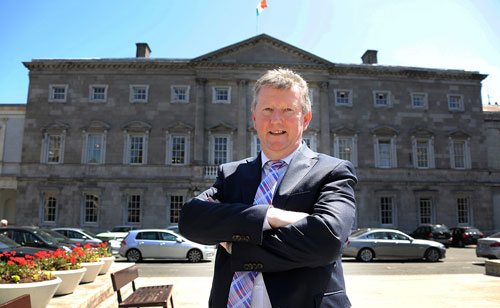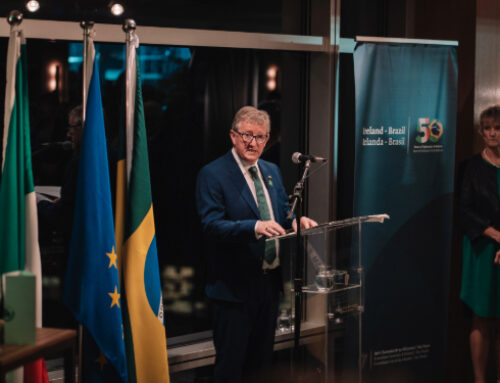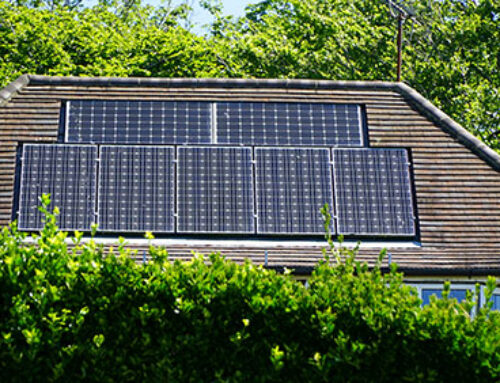As the National Broadband Plan continues to be delayed, rural affairs and digital development have rarely been so intertwined in Ireland. Odrán Waldron talks to Minister of State for Natural Resources, Community Affairs and Digital Development, Seán Canney TD about the broadband plan, the digitisation of agriculture and the need for further domestic online safety legislation.
With such a wide portfolio, Canney is one of many Ministers of State whose work covers more than one government department; rural and community development, as well as communications, climate action and Environment in his case. “In rural and community development, we fund the broadband officers for every county, and they work closely with the local authority to identify blackspots, areas of deficiency in broadband in preparation for the administration of rural broadband, which is being delivered by my other department,” he says, detailing how his various areas of responsibility overlap.
Rural Ireland has been waiting for the rollout of the National Broadband Plan since its announcement in 2012. This is a fact the independent TD for Galway East is conscious of: “We have 550,000 premises, predominantly in rural areas, who do not have broadband. That means we effectively have a two-tier society.
“If we add fibre to the home, as the NBP will deliver, people will be able to work from home, second and third-level students will be able to access information and do their projects from home. It would mean, because of the cost of accommodation, that students could commute to university and be able to do their work from home. From the point of view of small business, to be able to compete in the market they need to be as efficient as they can and having good strength broadband will afford them the opportunity to compete at the cutting edge.”
Where rural Ireland is concerned, agriculture is never far from the top of the agenda and digital development is something that Canney sees as crucial for the development of farming. “We need to make sure that our farming is utilising the best techniques and technology that area available to them,” he says. “Right now, if you want to apply for your entitlements from the Department of Agriculture, you have to do all of your business online.
“At the moment, a lot of farmers don’t have the facility to do that. Some don’t have broadband which means that the Department has to have days in the regions where they come out, set up the computers and bring in farmers to do it.”
With greater internet access comes the ability to innovate technologically; Canney is excited by the Internet of Things development he sees currently in the agriculture sector and by the prospect of where that will go. “There is now an app with cow facial recognition, so farmers can monitor their herd remotely and they might be able to see, for example, that the milking yield is down,” he says. “That way, you can put in protective measures if the cow has pneumonia, for example.
“All of these problems are being prevented and farmers are saving on medication and avoiding losses through disease. The other area that would help, and we’ve seen this being done internationally, is the use of drones for testing soils, weather and grain. This is where we’re going and 5G is part of that process. We’re moving with that; we would see the way farming is being digitised, allowing farmers to monitor their herds remotely, making farming more efficient and herds healthier.”
While agriculture does comprise a large part of rural life, it is not the only area set to benefit from the rollout of the broadband plan, with the EU’s Smart Villages and the Department of Communications’ Smart Community initiatives intricately tied to the provision of broadband in rural areas. “As part of the NBP rollout, the first thing we are doing is creating 300 hubs, where there will be a zone where people can come and use the internet within villages, towns and community centres,” Canney says.
“We’re also rolling out the digitisation of our public libraries so that people can access the libraries 24 hours a day. We have the likes of the Smart Communities, where Tubbercurry has been a pilot along with a number of other towns. It’s all about making sure that we are using all kinds of technologies that are there to make quality of life and standard of living a lot better for everybody. I think when everybody sees what’s going to go on in these towns as it progresses, they’ll see that we are future proofing these towns.”
However, there has been a creeping sentiment of resentment against the digitisation of the world in recent times, particularly regarding data protection and social media. This is a reality Canney acknowledges: “People have their rights to privacy and I’m not happy with the way Facebook is being used to attack people. I chair the National Online Safety Council which advises the Government; we do a lot of work in the area of online safety and that feeds into the work that Minister Bruton does moving things forward in terms of regulation. What I would call ‘the day of self-regulation’ is well over.
It’s all about making sure that we are using all kinds of technologies that are there to make quality of life and standard of living a lot better for everybody. I think when everybody sees what’s going to go on in these towns as it progresses, they’ll see that we are future proofing these towns.
— Seán Canney TD, Minister of State for Digital Development
“While the digital age has brought a lot of good things, we have to make sure that we are protecting our people and protecting the most vulnerable in society at the same time, especially our children. Online safety is a huge part of that, especially data and data protection. The difficulty with that is that digitisation is global and trying to introduce domestic legislation for global issues can be that little bit more difficult.
We do need a regulator in terms of online safety, and I think that’s the direction we are going with the legislation that Minister Bruton is bringing in.”
Negativity might surround the broadband plan, but Canney is bullish and optimistic about its eventual implementation: “The delays have been there, but I do believe that we will have the contract signed by the end of this year. There’s been a lot of posturing by third parties in terms of what they can and can’t do, but I see it on the ground myself, the complete absence of broadband in areas and providers have tried to put broadband in place and failed miserably.
“The Government should have to put broadband in place and that’s what’s happening. One of the things that I’m looking at when we plan for the future, for instance in terms of infrastructure such as roads or railways, is futureproofing in terms of the capacity of services underground. If you take the motorway from Galway to Limerick, if somebody wants 5G to run the autonomous vehicles of the future along the motorway, the work has been done under the ground, so the roads won’t have to be dug up. At the moment, while there’s the delay with the broadband, we are preparing our infrastructure to take whatever comes in the future. We have the Office of Public Works involved to see what business can be used to make sure that we have proper infrastructure and that we don’t have gaps going forward,” he concludes.
DEVELOPING RURAL IRELAND DIGITALLY
By Sean Canney|
2019-09-19T18:51:16+00:00
September 19th, 2019|Blog, Galway East, Homepage, Information, Latest News, National, Tuam Area|0 Comments





